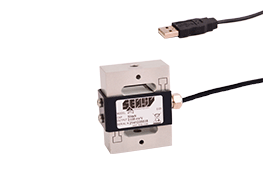Standard reference force transducers
TORQUE AND FORCE REFERENCE STANDARD TRANSDUCERS DESIGNED FOR DIFFERENT APPLICATIONS
SENSY has developed a range of reference standard force sensors designed for different applications (industrial testing machines, official calibration laboratories, portable calibration systems, tests according to ISO 7500, etc.).



With our experience, we are also able to design and manufacture standard reference transducers to meet our customers’ needs and constraints.
They can comply with the following standards:
Each of these standards imposes particular measurement features: for example, for ISO 376, they vary according to the accuracy class:

* : F.S. is the full scale of the force transducer.
** : R.O. is the rated output (i.e.: measured value). The mentioned values are only valid if R.O. >= 20% of full scale.
OUR PRODUCT RANGE
1. Standard reference compression load cells
3115-ISO
The 3115-ISO sensor is the most used since it offers a wide capacity range from 100 kN to 50 MN.
3115F-12390
This sensor makes it possible to check, in accordance with EN 12390-4, the testing machines used to qualify hardened concrete.
On request, it is also possible to calibrate this sensor according to ISO 376 up to the "0.5" class and thus to obtain a double certification for better portability, as well as saving money since it will no longer be necessary to purchase a standard sensor.
9115

This sensor has been designed to be used in testing machines with only a small opening between trays.
Its sturdiness and very low profile make it very popular.
2. Standard reference tension and universal (tension/compression) load cells
For information, the most common threads on these standard reference sensors are listed in ISO 376 or are compatible with it. For the most common standard reference force transducers, these threads are also compatible with the commonly used rod end bearings available on the market.
For the 271x-ISO load cells, rod end bearings with a male thread are available for all models.
3. Standard reference torque meters
SENSY standard reference torque meters have the same mechanical interfaces as the corresponding industrial models. However, to limit errors due to friction and slight displacement on the surfaces in contact, these interfaces can be oversized for greater accuracy and repeatability. The most used models for calibration applications are the following:
6500
For the verification of calibration wrenches, the calibration must either be carried out with the combined application of moments and transverse forces corresponding to those applied by the wrench, or be complemented by a specific test demonstrating the insensitivity of the torque meter to these transverse forces.
There is no international standard for the calibration of torque meters. However, a calibration guide has been established by the European metrology organisation EURAMET under the reference cg-14 / V.01 of July 2007 and is available on the website http://www.euramet.org. ISO 6789 gives a calibration procedure for calibration wrenches.
SENSY EXPERTISE
Beyond our standard product range of standard reference sensors, SENSY has developed significant expertise in the following fields:
Custom-made standard reference force transducers
(see examples below)


High capacity standard reference force transducers
Manufacturing and calibration of high capacity standard reference force transducers according to ISO 376
Above 16.5 MN, there is no testing machine available with an uncertainty equal to or better than 0.02% or even 0.05%, which does not enable qualification of standard reference force transducers for ISO 376 classes, such as "00"; "0.5" or even "1".
Nevertheless, the need exists and the market in very-high-capacity sensors is developing in parallel with the gigantic industrial installations worldwide. SENSY is privileged to have witnessed that situation, having manufactured several sensors in compression and/or in tension of 20, 25 and 30 MN.

Standard reference torque transducers
Manufacturing and calibration of standard reference torque transducers
The calibration of a torque meter has particularities compared to that of a dynamometer in that the known forces must be applied through a lever arm, the error of which must also be perfectly mastered. The applied torque is usually pure torque with the use of effective decoupling.

Strain gauge cylinder
A very important parameter in the testing of concrete compression test specimens is the uniform application of force on the specimen section. In order to verify the homogeneity of the repartition of the forces generated, the standard defines a strain gauge transducer, called strain gauge cylinder, as well as the tests to be carried out with it and the associated criteria.

Digitalisation of standard reference transducers
For a long time, national calibration laboratories were testing standard reference transducers with very accurate amplifiers and electronics that they owned.
This situation implied the use of similar electronics, also calibrated, to carry out transfer calibrations on the operation sites, which was extremely expensive both in terms of investment and in the costs related to their regular calibration.
For these reasons, for many years, SENSY has offered complete measurement chains for calibration, which are economically more accessible.











